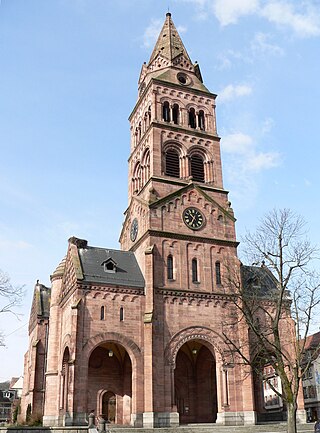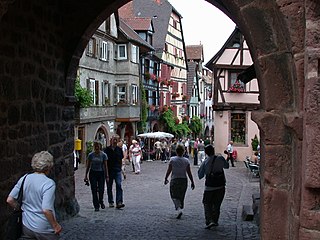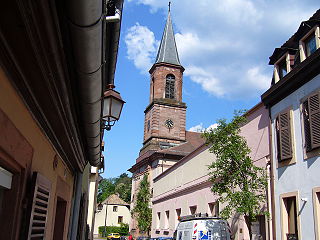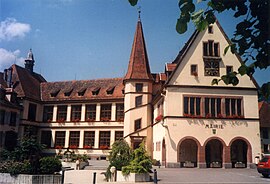
Alsace is a cultural region and a territorial collectivity in eastern France, on the west bank of the upper Rhine next to Germany and Switzerland. In January 2021, it had a population of 1,919,745. Alsatian culture is characterized by a blend of German and French influences.

Bas-Rhin is a département in Alsace which is a part of the Grand Est super-region of France. The name means 'Lower Rhine', referring to its lower altitude among the two French Rhine departments: it is downstream of the Haut-Rhin department. Both belong to the European Upper Rhine region. It is, with the Haut-Rhin, one of the two departments of the traditional Alsace region which until 1871, also included the area now known as the Territoire de Belfort. The more populous and densely populated of the pair, it had 1,152,662 inhabitants in 2021. The prefecture is based in Strasbourg. The INSEE and Post Code is 67.

Haut-Rhin is a département in the Grand Est region, France, bordering both Germany and Switzerland. It is named after the river Rhine. Its name means Upper Rhine. Haut-Rhin is the smaller and less populated of the two departments of the former administrative Alsace region, the other being the Bas-Rhin. Especially after the 1871 cession of the southern territory known since 1922 as Territoire de Belfort, although it is still rather densely populated compared to the rest of metropolitan France. It had a population of 767,083 in 2021.

The following is a list of the 366 communes of the French department of Haut-Rhin.

Sélestat is a commune in the Grand Est region of France. An administrative division (sous-préfecture) of the Bas-Rhin department, the town lies on the Ill river, 17 kilometres (11 mi) from the Rhine and the German border. Sélestat is located between the largest communes of Alsace, Strasbourg and Mulhouse.

Munster is a commune in the Haut-Rhin department in Grand Est in north-eastern France. It is located in the valley of the river Fecht, in the Vosges mountains about 15 kilometres west of Colmar on the D417 road to the Col de la Schlucht and Épinal.

Riquewihr is a commune in the Haut-Rhin department in Grand Est in north-eastern France.
Sundgau is a geographical territory in the southern Alsace region, on the eastern edge of France. The name is derived from Alemannic German Sunt-gowe, denoting an Alemannic county in the Old High German period. The principal city and historical capital is Altkirch.

Turckheim is a commune in the Haut-Rhin department in Grand Est in north-eastern France. It lies west of Colmar, on the eastern slopes of the Vosges mountains.

Thann is a commune in the northeastern French department of Haut-Rhin, in Grand Est. It is the sous-préfecture of the arrondissement of Thann-Guebwiller and part of the canton of Cernay. Its inhabitants are known as Thannois.

The Château du Haut-Koenigsbourg, sometimes also Haut-Kœnigsbourg, is a medieval castle located in the commune of Orschwiller in the Bas-Rhin département of Alsace, France. Located in the Vosges mountains just west of Sélestat, situated in a strategic area on a rocky spur overlooking the Upper Rhine Plain, it was used by successive powers from the Middle Ages until the Thirty Years' War when it was abandoned. From 1900 to 1908 it was rebuilt at the behest of the German kaiser Wilhelm II. Today it is a major tourist site, attracting more than 500,000 visitors a year.

Sainte-Marie-aux-Mines is a commune in the Haut-Rhin department and Grand Est region of north-eastern France.

TER Alsace was the regional rail network serving the région of Alsace, eastern France. In 2016 it was merged into the new TER Grand Est.

Ensisheim is a commune in the Haut-Rhin department in Grand Est in north-eastern France. It is also the birthplace of the composer Léon Boëllmann. The Germanic origins of the village's name reflect the area's history.

Saint-Hippolyte is a commune in the Haut-Rhin department in Grand Est in north-eastern France.

Bergholtz is a commune in the Haut-Rhin department in Grand Est in north-eastern France, and, since 1 January 2021, the European collectivity of Alsace. The commune is in the historic and cultural region of Alsace.

Colmar station is a railway station located in Colmar, in the Haut-Rhin département of Alsace, France. The same design was used in the construction of Gdansk's principal railway station in Poland. Thus the buildings are 'twins' of one another.

The arrondissement of Colmar-Ribeauvillé is an arrondissement of France in the Haut-Rhin department in the Grand Est region. It has 98 communes. Its population is 211,312 (2017), and its area is 1,247.9 km2 (481.8 sq mi).
The canton of Wintzenheim is an administrative division of the Haut-Rhin department, northeastern France. Its borders were modified at the French canton reorganisation which came into effect in March 2015. Its seat is in Wintzenheim.

The Province of Alsace was an administrative region of the Kingdom of France and one of the many provinces formed in the late 1600s. In 1648, the Landgraviate of Upper-Alsace was absorbed into the Kingdom of France and subsequently became the Province of Alsace, which it remain an integral part of for almost 150 years. In 1790, as a result of the decree dividing France into departments, the province was disestablished and split into three departments: Bas-Rhin, Haut-Rhin, and part of Moselle.






















